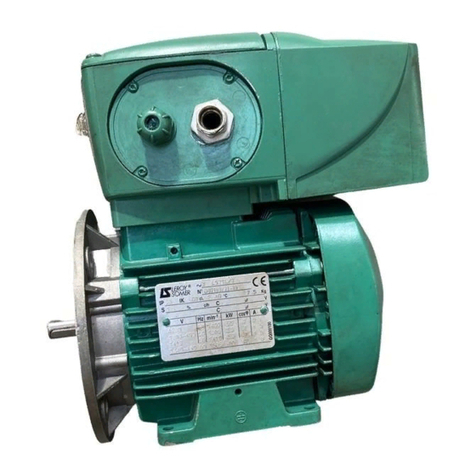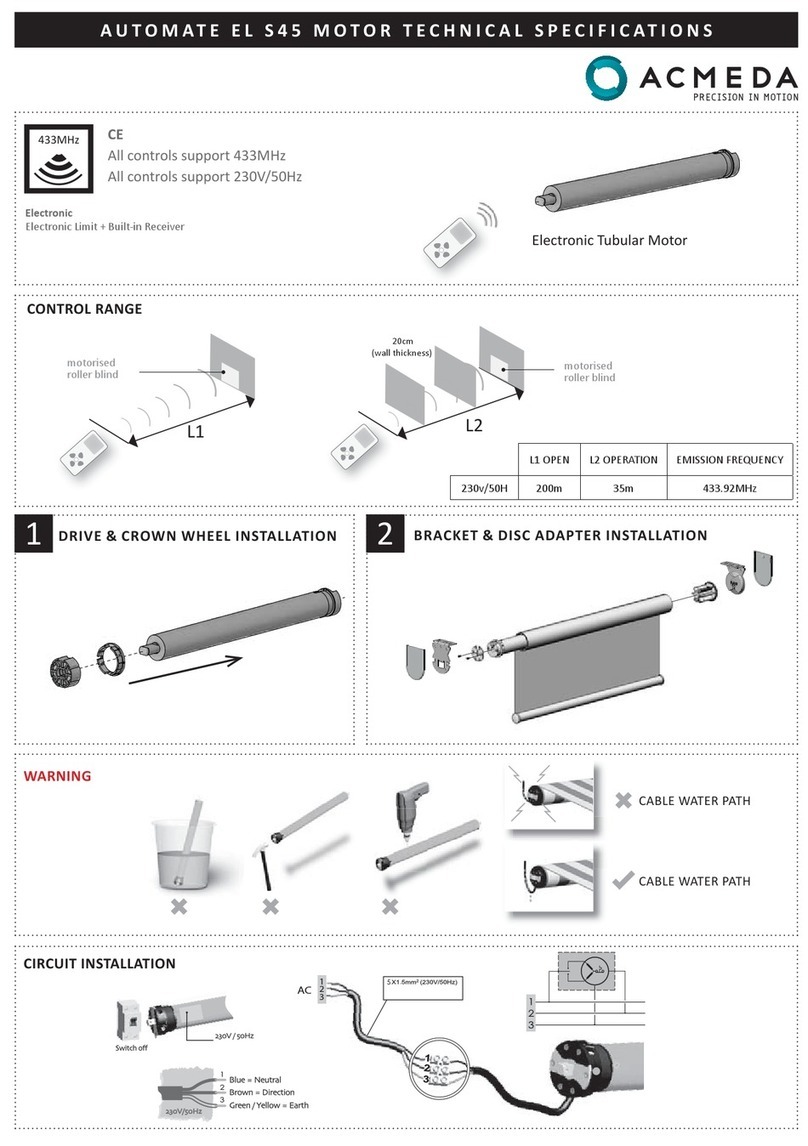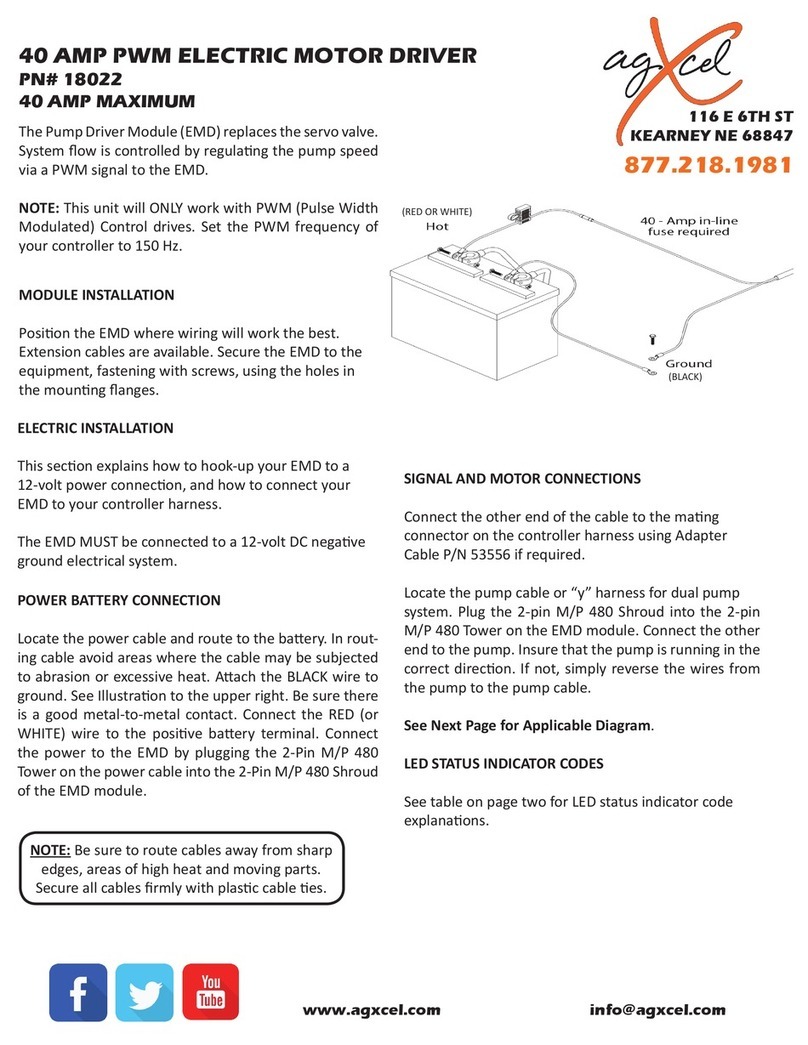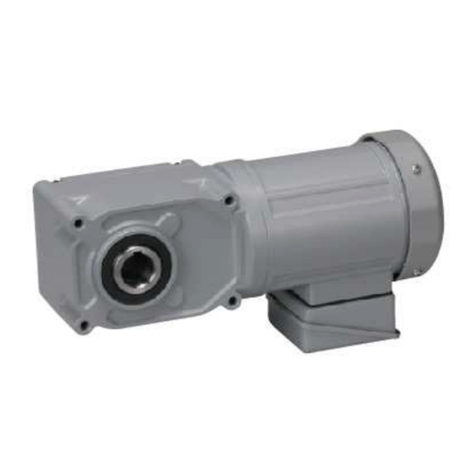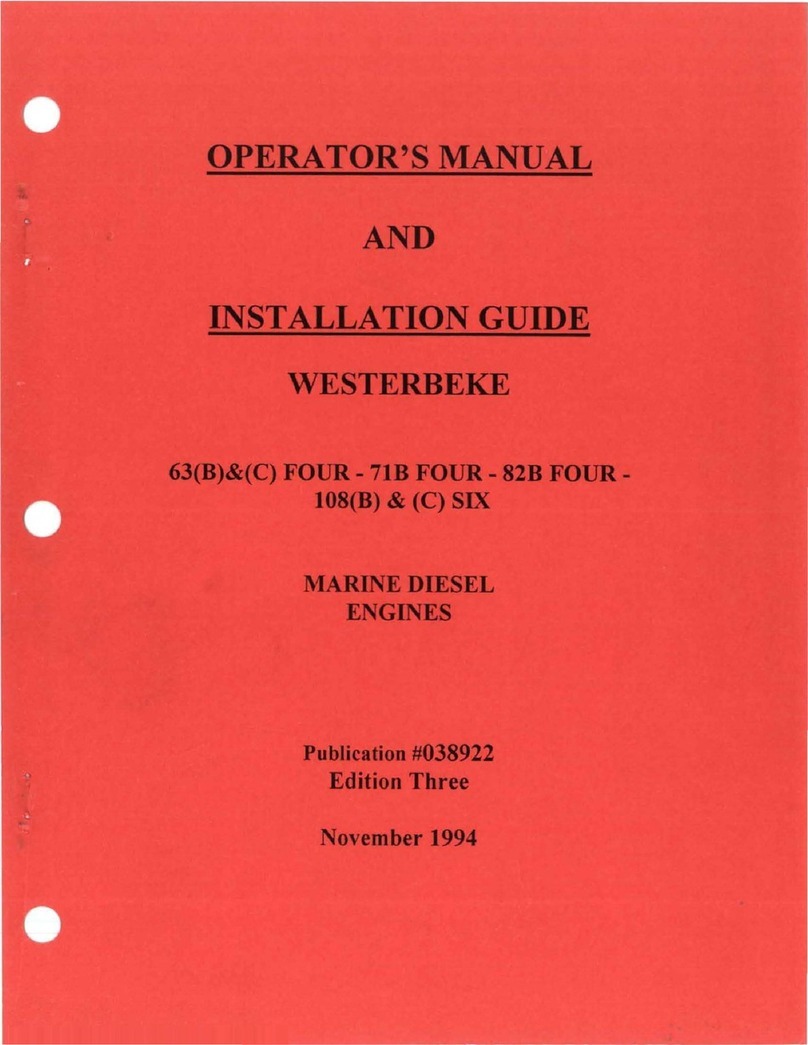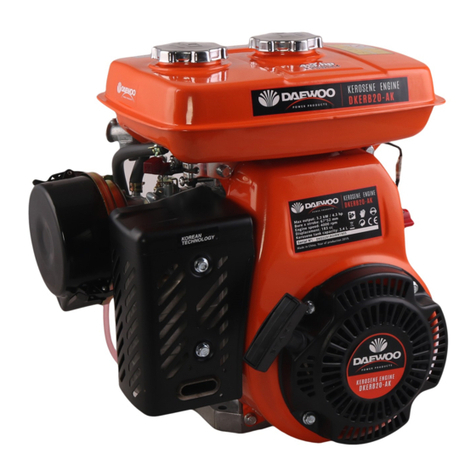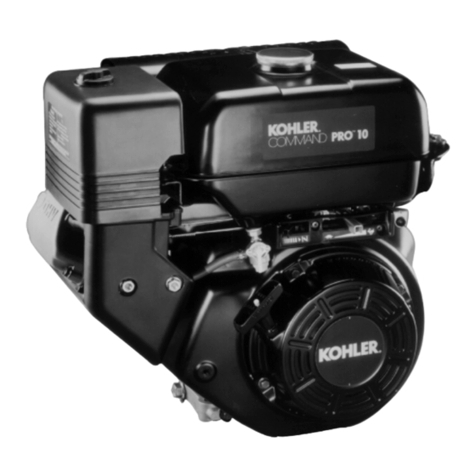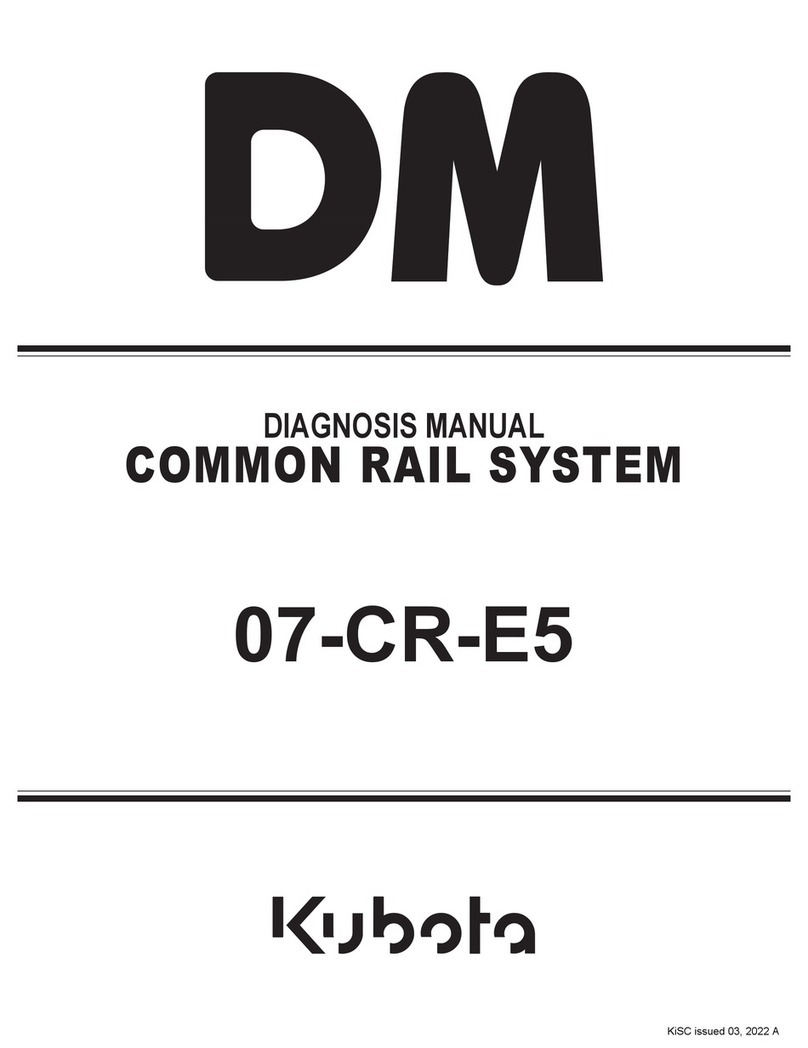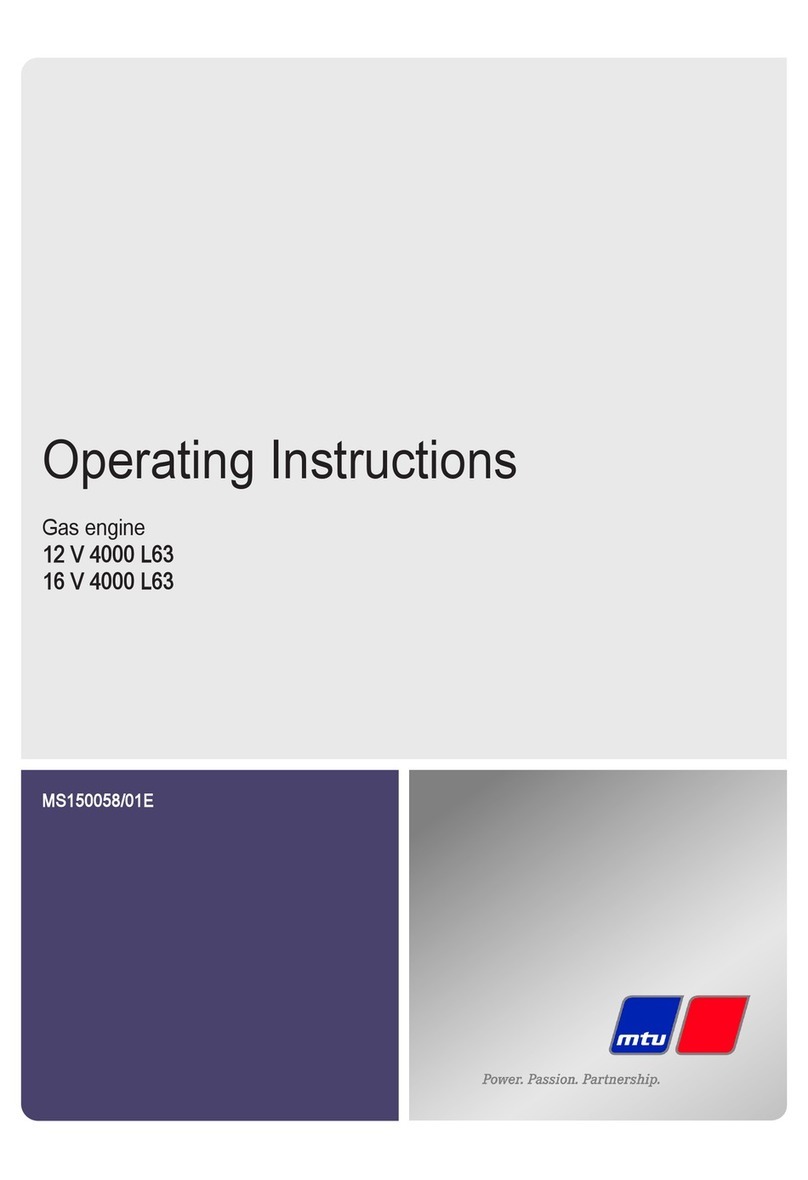V-max VMX-42PRO User manual

Model engines, model engine fuel, propellers, spinners and products such as this VMAX model engine can be hazardous
if improperly installed or improperly used. Be cautious and follow all safety recommendations when using your VMAX
model engine and any third party accessories. Keep hands, tools, clothing and all foreign objects well clear of engines
when they are operating. Wear safety glasses when starting or operating this engine. Take particular care to safeguard
and protect your eyes and fingers and the eyes and fingers of other persons who may be nearby. Use only a good quality
propeller that has no cracks or flaws. Stay well clear of the propeller and stay clear of the plane of rotation defined by the
propeller. Keep spectators and small children back at least 10 metres (33) feet at all times when operating the engine.
The manufacturer, distributor, retailer and/or other suppliers of this product expressly disclaim any warranties or represen-
tations, either expressed or implied, including but not limited to implied warranties of fitness for any purpose.
In no event will the manufacturer, distributor, retailer and/or other suppliers of this product have any obligation arising
from contract or tort, or for loss of revenue or profit, or for indirect, special, incidental, consequential or other damages
arising from the use of this product.
In purchasing and/or using this product, the user accepts all responsibility for its use and accepts all liability associated
with such use.
LIABILITY DISCLAIMER
It is important that the following liability disclaimer be
READ BEFORE INSTALLING OR USING THIS PRODUCT
Proceeding with Installation and/or Use of this product indicates
Agreement With and Acceptance of the Liability Disclaimer.
CAUTION
A model engine is not a toy. A model engine functions much like a full size engine. If you do not install and
operate this product properly you can cause injury to yourself and others and damage property.
DO NOT INSTALL OR USE this engine if you are not qualified.
You are solely responsible for the mechanical and operational integrity of this engine and the way in which it
is installed and used. Check all aspects of the installation, the engine, propeller, spinner and all other
accessories attached or associated with this engine before and after each use.
Do not operate the engine unless you are sure that it can be operated safely.
8
OWNERS
MANUAL
.049 5 x 3 5.25 x 4, 5.5 x 4, 6 x 3, 6 x 4 ,7 x 3
.09 7 x 3 7 x 4, 7 x 4.5, 7 x 5
.15 8 x 4 8 x 5, 8 x 6, 9 x 4
.19-.25 9 x 4 8 x 5, 8 x 6,9 x 5, 9 x 6
.20-.30 9 x 5 9 x 6, 9 x 7, 9.5 x 6, 10 x 5
.35-.36 10 x 4 9 x 6, 9 x 7, 10 x 5, 11 x 4
.40 10 x 5 9 x 8, 10 x 6, 11 x 5
.45-.47 10 x 7 10 x 6, 11 x 5, 11 x 6, 11 x 7, 12 x 4
.50 11 x 6 10 x 8, 11 x 7, 12 x 4, 12 x 5
.60-.61 11 x 7 11 x 7.5, 11 x 7.75, 11 x 8, 12 x 6
.70 12 x 6 11 x 8, 12 x 8, 13 x 6, 14 x 4
.78-.80 13 x 6 12 x 8, 14 x 4, 14 x 5
.90-.91 14 x 6 13 x 8, 15 x 6, 16 x 5
1.08 16 x 5 15 x 8, 18 x 5
1.20 16 x 7 16 x 8, 16 x 10, 18 x 5, 18 x 6
1.50 18 x 7 18 x 8, 20 x 6
1.80 18 x 8 18 x 10, 20 x 6, 20 x 8, 22 x 6
2.00 20 x 8 18 x 10, 20 x 6, 20 x 10, 22 x 6
2 STROKE ENGINE PROPELLER SIZES
(Diameter x Pitch in Inches)
Please note that the best propeller size for your engine
may vary considerably with altitude, air temperature, air
humidity, fuel, nitro content and aircraft drag. Experi-
enced flyers and your local hobby retailer may have
suggestions for optimizing performance in your flying
area.
As a general guideline, lower pitch results in more
torque (vertical pull) while higher pitch results in more
speed in level flight.
A crude method of comparing one propeller to another
for level flight performance is to calculate the Power
Factor as (2 x Diameter) + Pitch. The bigger the power
factor the higher the performance the propeller... pro-
vided that the engine can handle the corresponding
load. For example an 11 x 7 prop has a power factor of
29 while a 10 x 6 prop has a power factor of 26.
If your engine appears to running overly hot and below
peak RPM you should try a propeller with a lower power
factor.
ENGINE
SIZE
(cu in)
BREAK
IN AFTER BREAK IN
FUEL TANK POSITIONING
9mm (3/8”) Centre Line
of Fuel Tank
Recommended fuel tank size by engine displacement.
.10 cu in 60 cc (2 oz)
.19 120 cc (4 oz)
.25 120-180 cc (4-6 oz)
.29-.40 180-240 cc (6-8 oz)
.45-.50 240-300 cc (8-10 oz)
.60 360-420 cc (12-14 oz)
.76 420-480 cc (14-16 oz)
.90 480-600 cc (16-20 oz)
1.20 600-720 cc (20-24 oz)
Using too large a fuel tank can cause wide changes in
RPM as the fuel is consumed, wide changes in RPM
between inverted and upright flight, difficulties maintain-
ing a consistent fuel flow in vertical maneuvers etc.
Using too small a fuel tank will reduce flight times.
As the distance between the vertical position of the
needle valve and the centre line of the tank increases
the following performance characteristics may be
noted...
- more fluctuation in RPM between inverted and upright
flight.
- more fluctuation in RPM between full tank and low
tank due to mixture changes
- more of a need for muffler pressure to smooth out
RPM fluctuations noted above.
- harder starting, more need for primer to start when
engine is upright
- more of a tendency for flooding, fuel siphoning from
tank into engine and hydraulic lock when engine is
inverted.
FUEL TANK SIZE
VMAX is a Trademark of VMAR Manufacturing Inc. and authorized VMAX agents worldwide.
www.richmondrc.com
ENGINE TANK

SAFETY FIRST AT ALL TIMES
SAFETY INSTRUCTIONS
1) Use safety glasses when starting and operating your
engine.
2) Do not operate the engine near loose gravel, sand, small
particles or other debris. The rotation of the engine and
propeller can throw loose material into your face and eyes
and injure spectators.
SAFETY INSTRUCTIONS continued
3) Do not allow loose clothing such as shirt sleeves, ties or
scarves to come into contact with the engine, propellor,
spinner, crankshaft or other rotating or moving items attached
to the engine.
4) Remove all loose items from your shirt pockets, hat or
elsewhere so that they do not fall into the area near the
engine.
5) Make sure the glow plug ignitor, glow plug clip, glow plug
cord, starter cord, fuel line and other objects are well clear of
the propeller, spinner, crankshaft or other rotating or moving
items attached to the engine.
6) If you use a spinner make sure that the edges of the spinner
do not touch the propeller itself to prevent propeller failure and
injury caused by flying propeller blades.
7) Read the WARNING LABELS on fuel containers. FUEL IS
HAZARDOUS. Keep engine fuels in a safe place away from
children, sparks, heat or anything that could ignite the fuel. Do
not smoke near fuel or when fueling or operating your engine.
8) Operate your engine only in WELL VENTILATED AREAS.
Do not operate your engnine in a garage or other building.
Model engine exhaust contains carbon monoxide. Carbon
monoxide is toxic and should not be breathed.
9) Read the WARNING LABELS on propellers. Do not use a
propeller that has any nicks, scratches, splits, cracks or any
sign of wear or damage. Never alter or repair a propeller.
10) Use only a good quality propeller that has no cracks or
flaws. Stay well clear of the propeller and stay clear of the
plane of rotation defined by the propeller.
11) Keep hands, tools, clothing and all foreign objects well
clear of engines when they are operating. Take particular care
to safeguard and protect your eyes and fingers and the eyes
and fingers of other persons who may be nearby.
12) Keep spectators and small children back at least 10
metres (33 feet) at all times when operating the engine.
13) Use a “chicken stick” or electric starter for cranking the
engine.
14) Make all engine and carburetor adjustments while you are
behind the engine. Do not attempt to reach over a rotating
propeller or crankshaft.
15) Do not throw anything into a running engine to stop it. To
stop the engine, cut off the air supply by closing the carburetor
or cut off the fuel supply by pinching the fuel line leading to the
carburetor.
16) Be particularly cautious when moving or carrying your
model with the engine running. Make sure the propeller is well
away from you and others.
17) Do not operate the engine near electric power lines, wires,
antennas, highways or other hazardous areas.
18) Model engines become hot when running. Do not touch
any part of the engine when hot.
WHAT YOU WILL NEED TO OPERATE THIS ENGINE
To start your engine, you will need the following tools and
accessories.
- Glow fuel
- Fuel pump
- Fuel tubing
- Glow plug
- Glow plug wrench
- Glow plug battery with cord and clip, or
- Glow plug ignitor with built in battery
- Propeller
- Propeller wrench
- Chicken Stick, or
- Electric Starter with battery.
Particular attention should be paid to the following.
1) Glow fuel: Use only good commercial glow fuel containing
zero to ten percent nitro methane and 18-20% oil content
being a blend of castor oil and synthetic oil or all castor oil. Do
not operate this engine on home made fuel or with fuel having
less than 18% oil content or with fuel having synthetic oil only.
2) Glow plug: Use a medium to hot R/C long glow plug.
3) Propeller: Wooden propellers are preferred. If a spinner is
used, make sure the spinner is securely attached and that the
edges of the spinner do not touch the propeller. Ensure the
propeller and spinner are balanced. An unbalanced propeller
or spinner can cause damage to your engine and make it very
difficult to adjust the engine for reliable operation.
4) Glow plug battery or ignitor. Select a voltage (usually 1.5
or 2.0 volts) and capacity to ensure that the glow plug you
have selected will glow a bright orange for at least five
minutes.
Operating any model engine requires skill and continuous
safety precautions and considerations. This engine and the
model into which it is installed can develop a great deal of
power and speed. This power and speed can seriously
injure you and other people and do substantial damage to
property. If you are a beginner, be sure to get training from
someone who has experience in the safe installation and
operation of model engines before you attempt to install or
use this engine. Regardless of your experience level, we
recommend having a third party double check your
installation before operating this engine. You are solely
responsible for the mechanical and operational
integrity of this engine and the way in which it is
installed and used.
27
VXR-461010 CYLINDER HEAD - 46PRO [w/GASKET]
VXR-461033 PISTON PIN - 46PRO
VXR-461035 PISTON PIN RETAINER - 42PRO,46PRO,52PRO
VXR-461036 CYLINDER & PISTON - 46PRO
VXR-461036S CYLINDER, PISTON, CONROD & PIN SET - 46PRO
VXR-461040 CONNECTING ROD - 42PRO,46PRO,52PRO
VXR-462040 CRANKCASE COVER (BACKPLATE) - 42PRO,46PRO,52PRO
VXR-462050 CRANKSHAFT - 42PR0,46PRO,52PRO - 1/4x28 NF THREAD
VXR-462053 BEARING REAR ONLY FOR CRANKSHFT 42PRO,46PRO,52PRO
VXR-462055 BEARING FRONT ONLY FOR CRANKSHFT 42PRO,46PRO,52PRO
VXR-462060 CRANKCASE - 46PRO
VXR-462060S CRANKCASE WITH BEARINGS - 46PRO
VXR-462070 DRIVE WASHER & CONE - 42PRO,46PRO,52PRO
VXR-462080 PROP WASHER & NUT - 42PRO,46PRO,52PRO
VXR-462090 CARB RETAINER BOLT & NUT - 42PRO,46PRO,52PRO
VXR-463000 CARBURETOR COMPLETE (w/NVALVE) - 42PRO,46PRO,52PRO
VXR-463010 NEEDLE VALVE SET - 42PRO,46PRO,52PRO
VXR-463011 NEEDLE VALVE ONLY - 42PRO,46PRO,52PRO
VXR-463014 NEEDLE VALVE RATCHET SPRING - 42PRO,46PRO,52PRO
VXR-463015 NEEDLE VALVE HOLDER & GASKET - 42PRO,46PRO,52PRO
VXR-463020 CARBURETOR BODY & SPRAY BAR - 42PRO,46PRO,52PRO
VXR-463030 ROTOR SPRING - 42PRO,46PRO,52PRO
VXR-463040 CARBURETOR ROTOR - 42PRO,46PRO,52PRO
VXR-463050 THROTTLE ARM (LEVER) - 42PRO,46PRO,52PRO
VXR-463060 IDLE NEEDLE VALVE & O-RING - 42PRO,46PRO,52PRO
VXR-463070 FUEL INLET NIPPLE & GASKET - 42PRO,46PRO,52PRO
VXR-463080 THROTTLE STOP SCREW - 42PRO,46PRO,52PRO
VXR-464000 MUFFLER - 42PRO,46PRO,52PRO
VXR-464020 MUFFLER REAR PORTION ONLY - 42PRO,46PRO,52PRO
VXR-464030 MUFFLER LONG SCREW & NUT - 42PRO,46PRO,52PRO
VXR-465000 SCREW SET (x12 w/MUFFLER BOLTS) 42PRO,46PRO,52PRO
VXR-465030 MUFFLER SCREWS (2) - 42PRO,46PRO,52PRO
VXR-466000 GASKET SET (HEAD & BACKPLATE) - 46PRO
VXR-46400010 MUFFLER SPACER 10MM (25/64") FOR 42PRO,46PRO,52PRO
PARTS COMMON TO VMX-42PRO, 46PRO & 52PRO
PARTS UNIQUE TO VMX-42PRO
PARTS UNIQUE TO VMX-52PRO
VXR-401010 CYLINDER HEAD - 42PRO [w/GASKET]
VXR-401033 PISTON PIN - 42PRO
VXR-401036 CYLINDER & PISTON - 42PRO
VXR-401036S CYLINDER, PISTON, CONROD & PIN SET - 42PRO
VXR-402060 CRANKCASE - 42PRO
VXR-402060S CRANKCASE WITH BEARINGS - 42PRO
VXR-406000 GASKET SET (HEAD & BACKPLATE) - 42PRO
VXR-521010 CYLINDER HEAD - 52PRO [w/GASKET]
VXR-521033 PISTON PIN - 52PRO
VXR-521036 CYLINDER & PISTON - 52PRO
VXR-521036S CYLINDER, PISTON, CONROD & PIN SET - 52PRO
VXR-522060 CRANKCASE - 52PRO
VXR-522060S CRANKCASE WITH BEARINGS - 52PRO
VXR-526000 GASKET SET (HEAD & BACKPLATE) - 52PRO
VMAX ENGINE DIMENSIONS 42PRO, 46PRO, 52PRO
42PRO
46PRO
52PRO
ABCDEFGHLWt
Lengths shown in mm. (inches=mm/25.4) Wt shown in g (oz=g/28.4)
1/4 x 28
1/4 x 28
1/4 x 28
TBA
TBA
44
44
44
17.5
17.5
17.5
84
84
84
51
51
51
88
88
88
60
60
60
35
35
35
51.3
51.3
51.3
70
70
70
S=Shaft
Thread
520
Ask about the VMAR
Engine Test Stand
#VMA-ETS120
FUEL IS
HAZARDOUS.
Read Cautions
on Container

BREAKING IN YOUR ENGINE.
Your VMAX engine requires minimal break in time. We
strongly recommend the use of an engine test stand such as
the VMAR #VMA-ETS120 for the first running and break in of
your VMAX engine. You can do the first runs with your engine
installed in a model but it is not recommended.
We recommend breaking in the engine by running it at a very
rich setting for approximately 4 tanks of fuel. (32 oz)
1) Attach the muffler, muffler gasket & carburetor firmly to
your engine and carefully install a glow plug with washer into
the top of the engine and a suitable prop and spinner. See the
prop selection guide on the back page. Make sure the propeller
is firmly attached with the curved (usually printed as well)
surface facing forward. Use a wrench to tighten the propellor
nut & washer firmly.
2) Mount the engine on your test stand and connect the fuel
lines. Make sure the tank is the right size & that the fuel tank
horizontal center line is about 9mm (3/8”) below the needle
valve as illustrated on page 8. Fill the tank with good quality
glow fuel. See Page 2 for oil and nitro recommendations.
3) See Figure 1 and install the high speed needle valve and
turn the high speed needle valve (black knurled knob on the
side opposite from the muffler) slowly clockwise until it seats
and you begin to feel resistance. Then back the needle valve
out about 2-3/4 turns.
4) Stop now and ensure that you are following all of the safety
instructions.
5) With the throttle fully open (throttle arm fully forward), place
your finger over the carb inlet. WIth your other hand turn the
engine over several times counter-clockwise (as viewed from
the front) until you see fuel flowing from the tank to the
carburetor.
6) Connect the glow plug ignitor and reduce the throttle to
about 1/4 open. “Prime” the engine by squirting a small
amount (10 drops or so) of fuel into the carburetor inlet.
7) Using an electric starter or chicken stick start the engine in a
counter-clockwise direction (as viewed from the front). Never
use your fingers to start the engine.
8) When the engine fires make sure the engine is pushing air
back away from the rear of the engine. If not, remove the glow
plug ignitor and firmly pinch the fuel line running to the
carburetor to stop the engine.
9) With the engine rotating counter-clockwise and pushing air
back away from the rear of the engine, leave the glow plug
ignitor in place. Advance the throttle to full and back out the
needle valve a bit more to ensure that the engine is running
at full throttle but gurgling and spewing lots of oil and fuel out
of the exhaust. This very rich running is essential for a
smooth trouble free break in.
10) Let the engine run for a minute or so and then stop it by
removing the glow plug heat and pinching the fuel line
connected to the carburetor.
11) When the engine has cooled for 5 minutes of so, start it
again and turn the needle valve in 2-3 clicks to lean out the
mixture slightly The engine will run a bit more smoothly and
without as much excess fuel and oil coming out of the
muffler. Try to remove the glow plug ignitor and see if the
engine will continue to run on its own.
12) Repeat this process several times on the first tank, each
time running slightly longer and slightly leaner but never
running screaming fast and always with a gurgling sound and
a sloppy exhaust residue. Always let the engine cool between
runs.
13) Now fill up the tank and run the engine again without
leaning it out any more. Leave the needle valve rich with a
gurgling sloppy sound for now. Run for 2-3 minutes at a time
at first then gradually increase the run times to about 5
minutes each as you burn up 3-4 tanks of fuel.
14) After you have broken in the engine with 3-4 tanks of fuel,
set the idle stop screw so that the carb can just about but not
quite close. Loosen the idle stop screw, put a straight pin in
the carb barrel and rotate the barrel gently closed as far as
the pin will allow, then tighten the idle stop screw into
position. Do not adjust the low speed mixture at this time.
BREAKING IN YOUR ENGINE continued
INSTALLING THE ENGINE INTO YOUR MODEL
1) Check that all bolts on your engine are tight using the allen
wrench supplied. Do not overtighten or you will strip the bolt
hole threads, just make sure that the bolts are firmly seated.
2) See your model instructions for information about fitting
the engine into the model. Install the muffler and a prop with
spinner onto the engine and loosely fit the engine into the
model. Confirm clearances around the muffler, carburetor
inlet, throttle arm, needle valve, glow plug and propeller with
spinner. Confirm that fuel lines can run from the fuel tank to
the carburetor and muffler pressure nipple without kinking.
3) Ensure that the horizontal center line of the fuel tank is
approximately 9mm (3/8 inch) below the needle valve. See
the illustration on page 8.
4) Depending on the mounting system provided with your
model, firmly mount the engine into your modell.
5) Connect the appropriate fuel lines to the engine carburetor
and muffler pressure nipple. Do not get them mixed up.
3
ENGINE EXPLODED 3-VIEW
CARBURETOR EXPLODED 3-VIEW
1010
5000
6000
1036
2040
2050
2053
2060
1035
4030
2090
1033
3000
2055
2070
2080
6
3060
3040
3050
3030
3020
3080
3070
3015
3014
3011
3010
4020
1040
1036S
4000
2060S
FIGURE 1 - CARBURETOR
High Speed
Needle Valve
(Clockwise =
Leaner)
Top View
Side View
Throttle
Arm
Carburetor
Fuel Nipple
Idle Stop Screw
Carburetor
Air Inlet
Low Speed Mixture Screw
(Clockwise = Leaner)
Throttle
Arm
(Forward =
Faster)
THIS IS AN ABC ENGINE. IT WILL BE VERY TIGHT AT TOP
DEAD CENTER. THIS IS NORMAL. AFTER THE FIRST FEW
RUNS IT WILL LOOSEN UP SOMEWHAT BUT REMAIN
TIGHTER AT THE TOP WHEN COLD THROUGH ITS LIFE.
5030

OPERATING THE ENGINE IN YOUR MODEL
1) Ensure that you follow all of the safety
instructions when operating your engine.
2) Always remove the fuel lines from the
muffler and carburetor and fill up the fuel tank via the fuel feed
line that was running to the carburetor. When the tank is full,
re-install the fuel lines. Do not fuel up with the muffler
pressure line connected to the muffler.
3) Turn the high speed needle valve (black knurled knob on the
side opposite from the muffler) slowly clockwise until it seats
and you begin to feel resistance. Then back the needle valve
out about 2-1/4 turns. (See Figure 1)
4) With the throttle fully open (throttle arm fully forward), place
your finger over the carburetor air inlet. WIth your other hand
turn the engine over several times counter-clockwise (as
viewed from the front) until you see fuel flowing from the tank
to the carburetor. Make sure you always hand crank your
engine before using an electric starter or chicken stick.
5) Connect the glow plug ignitor and reduce the throttle to
about 1/4 open. “Prime” the engine by squirting a small amount
(10 drops or so) of fuel into the carburetor inlet.
6) Using an electric starter or chicken stick start the engine in a
counter-clockwise direction (as viewed from the front). Never
use your fingers to start the engine.
7) When the engine is running, remove the glow plug ignitor
and open the throttle fully. Hold the nose of the aircraft
straight up and slowly turn the high speed needle valve
clockwise in steps of about 1/8 of a turn. Listen carefully as
the engine RPM increases. When you get to the point that the
engine RPM is near its peak, back the needle valve off
counter-clockwise about 1/8-1/4 of a turn and lower the nose
of the aircraft to level. At full throttle with a full tank and a
level attitude the engine should be running with a slightly rich
gurgle. As you lift the nose of the aircraft, the engine should
lean out slightly. If in doubt always err on the side of being a
bit too rich when the tank is full and the nose is held high.
8) Adjust the low speed idle stop screw and your servo throws
so that at normal mid trim position on your throttle the engine
is running just above the point where it stops. Ensure that the
engine will stop when you pull back on the throttle trim or
when you hit your “kill throttle” button if you radio offers this
feature.
9) We suggest adjusting the low speed mixture only if
necessary and only after the engine is well broken in. Trying
to adjust the low speed mixture on a new engine that has not
been broken in will be very frustrating and generally does
more harm than good.
10) The low speed mixture screw is a small brass screw
recessed into the center face of the throttle arm. The best way
to check and set the low speed mixture is to warm the engine
up for 5 minutes or so at full throttle and then reduce the RPM
to idle, wait 30 seconds and then pinch the fuel line to cut off
fuel flowing to the carburetor.
- If the engine speeds up slightly before quitting, the low
speed mixture is about right and should not be adjusted,
- If the engine quits without speeding up slightly, the low
speed mixture is a bit too lean... richen the low speed mixture
by backing the low speed mixture screw out counter-clockwise
about 1/8 of a turn.
- If the engine speeds up considerably before quitting, the low
speed mixture is too rich, lean out the mixture by turning the
low speed mixture screw in clockwise about 1/8 of a turn. 45
CARE AND MAINTENANCE OF YOUR ENGINE
TROUBLESHOOTING
THINGS YOU SHOULD NOT DO!
1) Please read over the section entitled “THINGS YOU
SHOULD NOT DO”.
2) Do not run your engine in dirty, dusty conditions.
3) Use clean filtered commercial fuel. Install a fuel filter on
your pump to filter fuel as it goes into your fuel tank.
4) After each flying session
- run the engine dry by pinching the fuel line feeding the
carburetor and let the engine run out of fuel. Pump out your
fuel tank then re-connect all fuel lines.
- remove the glow plug and carefully put 6-10 drops
of afterrun oil (Pacer After Run recommended) into
the combustion chamber and another 6-10 drops
into the carburetor inlet. Turn the engine over by
hand 10 times. Reinstall the glow plug, close the
carb and insert a small plug of wadded paper towel
into the carburetor intake.
- use a stiff tooth brush and Fantastic or other non-abrasive
household cleaner (dish soap and water will work) and clean
all surfaces of the engine paying particular attention to
thoroughly clean the head and all cooling fins.
5) Make sure your propellor and spinner are clean and
balanced at all times. Discard your propeller if you find any
cracks, splits or nicks.
6) Make sure your fuel container is firmly closed.
Your VMAX engine will last a long time if you take care of it. On the other
hand you can ruin an engine pretty easily if you ignore the following
1) DO NOT... run the engine in dusty dirty conditions.
2) DO NOT... run your engine after a crash without clearing dirt, grit and
other debris from the engine.
3) DO NOT... use low grade home brew fuel.
4) DO NOT... use fuel with less than 18% oil content
5) DO NOT... use fuel with only synethic oil in it. Make sure your fuel has
all castor oil or a blend of castor and synthetic oil.
6) DO NOT... forget to break in the engine carefully, preferably on an
engine test stand like the VMAR #VMA-ETS120
7) DO NOT... push the engine too hard, too fast, too lean or too hot. If you
see oil residue literally burning onto the sides of the head to form a brown
varnish... you are running too hot. If the hear the engine “sag off” at high
RPM you are running the engine too lean and it is overheating.
8) DO NOT... fuel up with the fuel line attached to the muffler. You run the
risk of flooding the engine.
9) DO NOT... hit the engine with an electric starter without turning it over
by hand first. If the engine is flooded and has a hydraulic lock and you hit
it with an electric starter you will bend the wrist pin or connecting rod or
blow a hole in the top of the piston. Pretty much the dumbest and sadly
the longest standing most popular way to ruin an engine!
Your VMAX engine has been precision machined to give reliable and
powerful performance with a minimum of break in and adjustment.
In the event that you have trouble getting your engine to start or operate
smoothly please review the following troubleshooting tips.
1) DO NOT PANIC! Just about everything has a cause and an effect and
with a bit of patience you can solve just about any problem.
2) READ THE INSTRUCTIONS. Even if you have read them once, read
them again and fix anything you may have missed.
3) CHANGE ONLY ONE THING AT A TIME. Do not change 5 things at
once, change one thing at a time and if the problem does not go away,
revert back to the way you had it before the change.
4) MAKE SMALL CHANGES. Do not use a hammer and pipe wrench
like you are doing home plumbing or working on a tractor. Use small hand
tools and make slight careful adjustments. Do not overtighten any of the
bolts or you can strip the threads and then you are in big trouble. After a
small change, test the results before you change anything else. If the
problem got worse, go back the other way on your adjustment.
5) CHECK THE SIMPLE THINGS FIRST. Your VMAX Engine is a
precision made and elegantly simple piece of machinery. The simple
things really do matter. Before you go off and start field stripping your
carburetor check the following...
- make sure the carburetor is seated on the O-ring seal and firmly held
into the engine by the retaining bolt.
- try a different glow plug and glow plug washer.
- make sure your glow plug ignitor makes the plug glow bright orange and
that it can keep the plug glowing well for at least 5 minutes.
10) DO NOT... leave fuel in the engine at the end of a flying session.
Rust will start to form on the bearings also immediately! Run the engine
dry of fuel by pinching the fuel line to the carburetor while the engine is
running and keep the fuel line pinched until the engine stops for lack of
fuel.
10) DO NOT... forget to use a good quality after run oil like Pacer After
Run when you are finished for the day. After Run inhibits rust and keeps
all the parts from gunking up with left over combustion oil.
11) DO NOT... continually adjust and muck around with the engine. Once
you get it set up, only slight occasional adjustments are necessary to
accomodate changes in ambient conditions like temperature and
humidity. People with chronic “adjusticitis” usually adjust things until they
don’t work... then they call for an expert!
12) DO NOT... take your engine apart unless absolutely necessary. If you
do take your engine apart it should only be because it is not working well.
Usually you will not be able to do much aside from clean it out and/or
replace worn parts. Note carefully how to reassemble it.
13) DO NOT... forget to clean the engine exterior after each flying
session. Leaving oil and baked on residue on the exterior of the engine
will reduce the cooling effectiveness of the head, fins and case and
contribute to over overheating and premature wear.
14) DO NOT... use power tools or over tighten any of the bolts or you will
strip the threads.
THINGS YOU SHOULD NOT DO continued
6) SOME MORE SIMPLE THINGS TO CHECK.
- make sure that your fuel is clean and good quality. Have a friend fly a
tank of your fuel to make sure it performs well.
- check your fuel tank and tubing all the way from the muffler, back into
the fuel tank and back through the cluck to the carburetor. No leaks, no
kinks! Pull the pressure line from the muffler and try blowing in the
muffler pressure line while pinching the carburetor fuel feed line... no
leakage of fuel or air should occur. Now pull the fuel feed line from the
carb and blow gently into the muffler pressure line... fuel should come
out of the fuel feed line.
- turn the high speed needle valve in until it seats, counting the turns as
you go for reference. Now back the needle valve out and remove it. Clean
the end of the needle. With the fuel feed line connected to the carb, close
the carburetor barrel, turn the engine over and blow gently into the
muffler pressure line and make sure that fuel flows into the carb fuel
nipple and into the carb and out the needle valve receptacle. Blow gently
and in short bursts to flush the carb without flooding it with fuel. Reinstall
your needle valve as before and reconnect the pressure and fuel feed
lines.
7) ASK A COMPETENT FRIEND FOR HELP. Check around at the
flying field and you will notice that some people arrive at the field, set up
their gear, do their checks, fuel up and fly fly fly with little in the way of
grief or trouble. This the kind of helper you want! Someone who knows
their stuff and can help you sort out a problem carefully. Stay away from
the verbose self-proclaimed “experts” who tend to spend all their time
adjusting this and that but seldom get it in the air or when they do,
seldom land with the engine still ticking over and the airplane in 1 piece!
8) USE AN ENGINE TEST STAND. When you have trouble with an
engine in a model you can spend a lot of time trying fix an engine
problem only to find later that it is a fuel tank problem, vibration problem
or other difficulty inherent with the model rather than the engine. A test
bench really helps you set up an engine properly and you can change
fuel tubing, fuel tank height, props, spinners, glow plugs etc much easier
on a test stand.
TROUBLESHOOTING continued
VMAX WARRANTY
WHEN YOU NEED PARTS OR SERVICE.
Your VMAX engine is warrantied to the original buyer to be free of
manufacturing defects for a period of 1 year from date of purchase.
Problems caused by normal wear and tear, crash damage, abuse,
improper use, failure to comply with the break in and operating instruc-
tions, customer disassembly, use of substandard fuel or damage caused
by use of other accessories are not covered by this warranty.
All warranty returns MUST be accompanied by a dated sales
receipt from an authorized VMAX re-seller and the original VMAX
box. Warranty returns must be sent to the VMAX Service Center in
your market area.
1) Parts are available through your retailer or On-Line at
www.richmondrc.com. Please see the parts list on page 7.
2) For repairs please remove the engine from your model and send the
complete engine including muffler and carburetor to the VMAX Service
Center in your market area. Please visit www.richmondrc.com for the
location of the Service Center in your market area.
3) Attach a short note explaining the difficulty you are having, fuel type
used, glow plug used, propellor used etc. Be certain to include your name,
address, day and evening phone numbers and your email address.
This manual suits for next models
2

